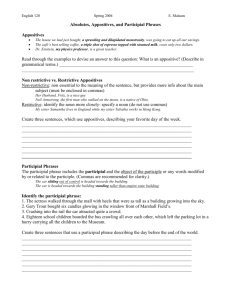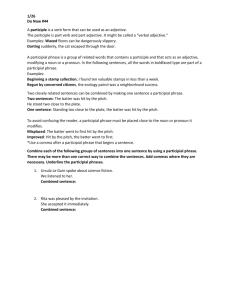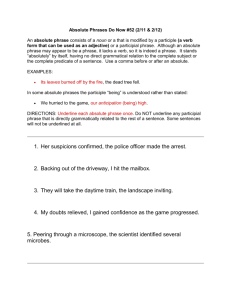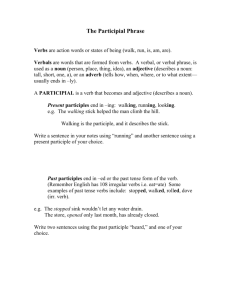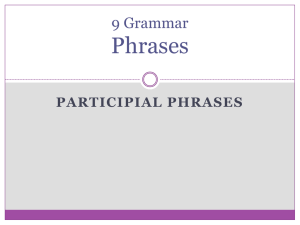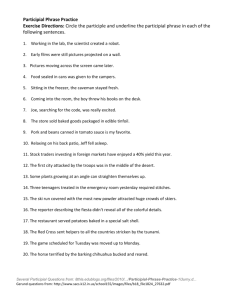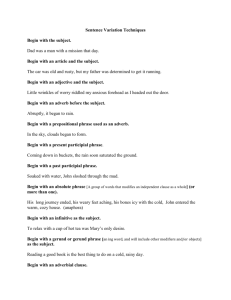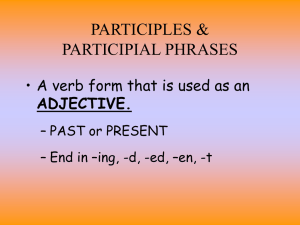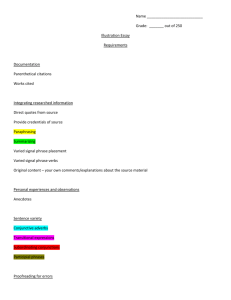LESSON PLAN
advertisement
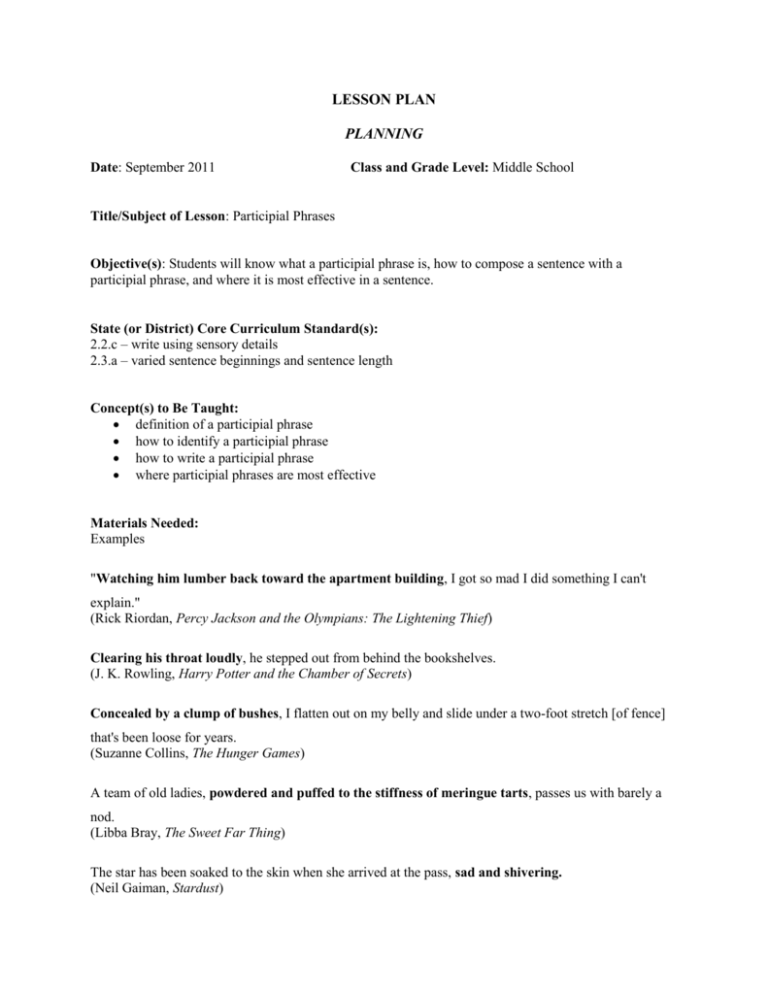
LESSON PLAN PLANNING Date: September 2011 Class and Grade Level: Middle School Title/Subject of Lesson: Participial Phrases Objective(s): Students will know what a participial phrase is, how to compose a sentence with a participial phrase, and where it is most effective in a sentence. State (or District) Core Curriculum Standard(s): 2.2.c – write using sensory details 2.3.a – varied sentence beginnings and sentence length Concept(s) to Be Taught: definition of a participial phrase how to identify a participial phrase how to write a participial phrase where participial phrases are most effective Materials Needed: Examples "Watching him lumber back toward the apartment building, I got so mad I did something I can't explain." (Rick Riordan, Percy Jackson and the Olympians: The Lightening Thief) Clearing his throat loudly, he stepped out from behind the bookshelves. (J. K. Rowling, Harry Potter and the Chamber of Secrets) Concealed by a clump of bushes, I flatten out on my belly and slide under a two-foot stretch [of fence] that's been loose for years. (Suzanne Collins, The Hunger Games) A team of old ladies, powdered and puffed to the stiffness of meringue tarts, passes us with barely a nod. (Libba Bray, The Sweet Far Thing) The star has been soaked to the skin when she arrived at the pass, sad and shivering. (Neil Gaiman, Stardust) To the west, over the Pacific, the sky was still faintly blue, clinging to the memory of day. (Paul Fleischman, Whirligig) Strategies to Be Used: Modeling, independent practice, sentence imitation, scrambling PERFORMING Announcements: none Continuation from Previous Lesson: We have been writing our personal narratives; today students will practice detailed and descriptive writing, and varying sentence length by going over their essays and inserting participial phrases. Lesson Presentation: A) Preparing for Learning: [anticipatory set] Begin by showing the students the examples without the participial phrases. Read through each quotation together and ask the students what they think about these sentences. Are they descriptive? Are they interesting? Can you picture the subject doing the action? Now show them the examples with the participial phrases included. Compare and contrast the sentences without participial phrases to the sentences with participial phrases. What is different about the sentences now (besides being longer)? Which sentences do they like better? Describe to the students that these examples all contain participial phrases. What determines a participial phrase? Students will confer with classmates sitting near them. After a few minutes of brainstorming in small groups, call the class together and copy their accurate observations of participial phrases on the board. The following are things the students may have noticed: * the bolded parts of the sentences are isolated with commas * the p.p. has an –ing or –ed word * tells action * describes * fits at the beginning, in the middle, or at the end of the clause. Explain that these elements make up an participial phrase. B) Directing the Learning: [learning activities] Modeling, sentence imitation * Take Libba Bray’s sentence, “A team of old ladies, powdered and puffed to the stiffness of meringue tarts, passes us with barely a nod. Imitate this sentence by creating a different participial phrase. Example: “A team of old ladies, gossiping about acrylic nails and hair dye, passed us with barely a nod.” Does this sentence follow the guidelines of a participial phrase? Ask students to place the participial phrase somewhere else in the sentence. Where do they like it best? Why? Point out that the participial phrase modifies the subject of the sentence (the “team of old ladies” in this case) and that the participial phrase should stay relatively close to the subject . . . otherwise it can be confusing. Guided practice, sentence imitation * Ask students to get out a piece of paper and choose a sentence to imitate. Instead of copying the bolded words, students should leave some blank space. Students will then fill in the blanks to create their own participial phrase. Guided practice, scrambling, independent practice Look at this quote from Louise Rennison’s, Dancing in My Nuddy-Pants “Jas and I got split up somehow from the rest of the gang.” Ask the students if they know the subject of the sentence. After students identify “Jas and I,” as the subject, ask students to fill in the blank, describing more about the subject. “Jas and I , ______________________, got split up somehow from the rest of the gang.” Now ask students to try to find a simple clause in their personal narratives. Use a student’s sentence, ask the students to identify the subject. With the class, add a participial phrase to the student’s work. Emphasize that they are describing and/or modifying the subject of their sentence C) Reinforcing the Learning: Independent Practice Now it’s time for you to read over your narratives. Can you insert a participial phrase to make your writing more colorful and engaging? Can you identify the subject of a sentence and continue to further describe that subject? Where do participial phrases work best? At the beginning, middle, or end of a sentence? I’ll be walking around the room to offer help if you need it. Assignment: You must include at lease three participial phrases in your personal narrative. Please underline it in the final draft. Evaluation: Were the quotations confusing or clear? Did the students understand the elements that make up a participial phrase? How do participial phrases change a sentence/piece of writing? Were the practice sentences helpful in the students’ understanding of the concept? Can the students justify why sentences with participial phrases tend to be more interesting than a regular clause?
